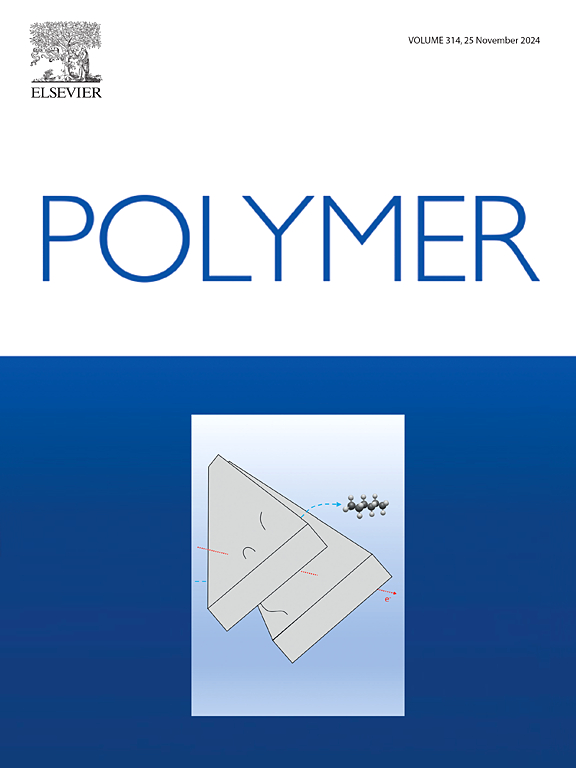Sustainable epigallocatechin gallate-based polycarbonate vitrimers with flame-retardant and antioxidant properties for closed-loop recyclable carbon fiber composites
IF 4.1
2区 化学
Q2 POLYMER SCIENCE
引用次数: 0
Abstract
Sustainable polycarbonate (PC) vitrimers were synthesized through a green one-step reaction between biomass-derived epigallocatechin gallate (EGCG) and bis(6-membered cyclic carbonate) (BCC). These EGCG-based networks exhibit exceptional mechanical properties, flame retardancy, antioxidant capacity, self-healing ability and reprocessability. EGCG content significantly affects the performance of the resulting networks. As the EGCG content increases, the mechanical properties, stress relaxation, flame retardancy, antioxidant capacity were improved. The increased EGCG content enhances crosslinking density, resulting in superior flame retardancy with a UL-94 V-0 rating and limiting oxygen index (LOI) of 28.1 %. The dynamic network structure enables efficient stress relaxation, retaining over 80 % of mechanical properties after three reprocessing cycles. Additionally, the material exhibits thermal self-healing efficiency of 90 % through transcarbonation-driven network rearrangement. Additionally, EGCG-based carbon-fiber composites achieved close loop recycling, addressing environmental concerns while maintaining high performance. Present strategy simultaneously enhances recyclability, fire safety, and sustainability, offering a circular economy-aligned solution for polymers used in electronics, automotive, and aerospace applications.


可持续的表没食子儿茶素没食子酸酯基聚碳酸酯树脂,具有阻燃和抗氧化性能,用于闭环可回收碳纤维复合材料
以生物质源的表没食子儿茶素没食子酸酯(EGCG)和双六元环碳酸酯(BCC)为原料,通过绿色一步反应合成了可持续聚碳酸酯(PC)玻璃聚合体。这些基于egcg的网络具有优异的机械性能、阻燃性、抗氧化能力、自修复能力和再加工性。EGCG含量显著影响所得网络的性能。随着EGCG含量的增加,材料的力学性能、应力松弛性、阻燃性、抗氧化能力均有所提高。EGCG含量的增加增加了交联密度,从而获得了良好的阻燃性能,其UL-94 V-0等级和极限氧指数(LOI)为28.1%。动态网络结构实现了有效的应力松弛,在三次再加工循环后保留了80%以上的机械性能。此外,通过转碳化驱动的网络重排,材料表现出90%的热自愈效率。此外,基于egcg的碳纤维复合材料实现了闭环回收,在保持高性能的同时解决了环境问题。目前的战略同时提高了可回收性、防火安全性和可持续性,为电子、汽车和航空航天应用中使用的聚合物提供了一个符合循环经济的解决方案。
本文章由计算机程序翻译,如有差异,请以英文原文为准。
求助全文
约1分钟内获得全文
求助全文
来源期刊

Polymer
化学-高分子科学
CiteScore
7.90
自引率
8.70%
发文量
959
审稿时长
32 days
期刊介绍:
Polymer is an interdisciplinary journal dedicated to publishing innovative and significant advances in Polymer Physics, Chemistry and Technology. We welcome submissions on polymer hybrids, nanocomposites, characterisation and self-assembly. Polymer also publishes work on the technological application of polymers in energy and optoelectronics.
The main scope is covered but not limited to the following core areas:
Polymer Materials
Nanocomposites and hybrid nanomaterials
Polymer blends, films, fibres, networks and porous materials
Physical Characterization
Characterisation, modelling and simulation* of molecular and materials properties in bulk, solution, and thin films
Polymer Engineering
Advanced multiscale processing methods
Polymer Synthesis, Modification and Self-assembly
Including designer polymer architectures, mechanisms and kinetics, and supramolecular polymerization
Technological Applications
Polymers for energy generation and storage
Polymer membranes for separation technology
Polymers for opto- and microelectronics.
 求助内容:
求助内容: 应助结果提醒方式:
应助结果提醒方式:


